Stories, Food, and Place:
Following a Sephardic Family to a New Home
By Rosemary Lévy Zumwalt1
“You use White Lily flour for biskochos and burekas, Pillsbury flour for roskas, and you use Winn Dixie rice,” my mother-in-law advised. There was to be no deviation on ingredients: these were the ones that produced results by replicating the taste of home.
Caden Musafir Lévy Israel (1905-2001) was born in Milas, Turkey; moved to Rhodes as a young girl, married and had a family; left Rhodes in 1939, as a refugee from the Mussolini government with her mother, Sarota Amato Musafir, and ten-year old son, Isaac Jack Lévy, for the international city of Tangiers, Morocco; and from there immigrated to the United States through the Port of New Orleans in February 1945, to live in the Sephardic community in Atlanta, then Brooklyn, and then back to Atlanta.
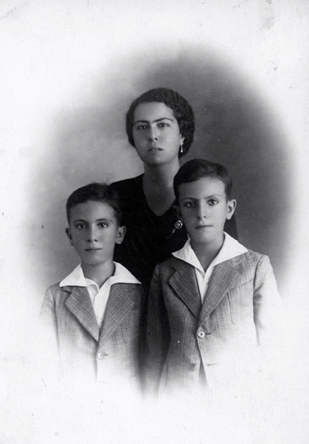
Left to right: Isaac, Mama, and Julian, circa 1934
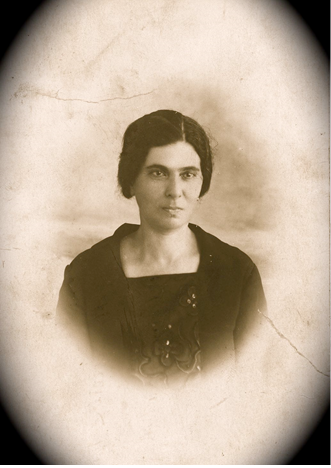
Grandma Sarota Amato Musafir
This paper will trace the journey of my husband’s family through their stories about food and foodways at the crossroads and transitions of making a new life. These personal experience narratives, which I have collected from my husband, with a few from myself, will reveal the foundational layers of tastes and aromas remembered from time past, of new foods in a new country, and of my mother-in-law trying to teach her granddaughter, Cathy, and me how to make burekas and biskochos.2 At the crossroads and in the transitions, the family unit of mother, grandmother, and son found themselves in new domestic spaces, and these spaces opened to new foods, indeed, to new un-kosher, or taref foods.
In From the Jewish Heartland: Two Centuries of Jewish Foodways, Ellen Steinberg and Jack Prost write about “traditional Jewish dishes” carried to America, “embedded only in women’s memories, inscribed in their work-worn hands.” The authors continue, “These foods were ‘tastes of home,’ yes, but ones that changed and evolved” (2011, 2). In “Migrant Seasoning: Food Practices, Cultural Memory, and Narratives of ‘home’ among Dominican Communities in New York City,” Lidia Marte writes of “food narratives” as providing for “historical reimagings and memory seasonings” of a home left behind (2008, 312). Marte reflects further, “Food has the power to ground us in-place and at the same time (through memory) helps us transcend our present moment. Our early food socialization leaves deep marks in the ways we perceive, relate, consume and imagine a sense of ‘home’ in the world” (2008, 1). In discussing the food narratives of Isaac and his family, I will draw from Steinberg and Prost’s concept of “‘tastes of home,’” that have “changed and evolved,” and Marte’s focus on “food narratives” as providing reimagined “memory seasonings” and “senses of home.”
Of course, this journey to new lands had been made before, not by Isaac’s family, but by his ancestors, centuries ago. Expelled from Spain in the 15th century, the Sephardim who had found their way to the Ottoman Empire retained some of the flavor of their lost home in the foods they selected and prepared, as they blended in the taste of their new home. The sandilla that they had eaten in Spain became karpus in Turkey, what is known also as watermelon. They especially adopted the herbs and spices of the Ottoman Empire and some became spice merchants selling in stalls open to the street just as the Ottoman Turks did. The desserts had the elegance of the Ottoman Turks and the special touch of the Sephardic women who made them.
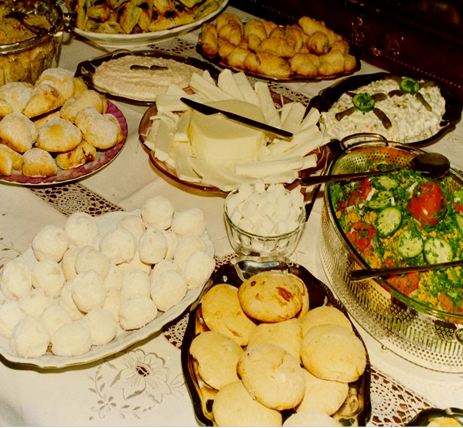
Sweets and salads, Wish party, Istanbul, Turkey, 1990, photo by Zumwalt
At home in Rhodes
Isaac remembers at the end of the day, sitting around the table: “At night, my grandmother used to say, ‘Agora, ya komimos, kualo vamos a komer manyana?’ [We already ate today, what are we going to eat tomorrow?].” Isaac continued, “Meals were a big thing – three meals a day. When we went to school, we used to come home and eat.” Isaac’s mother and grandmother used to cook outside in the portal (threshold), right outside the door. Isaac recalled, “We had a small mangal [brazier] and we used coal, and they cooked also on a kerosene stove.” They had a small burner inside on which to cook rice, vegetables, stew, and other items. For baked goods – bread, roskas, pasteles, burekas, boyos – they would carry the food on trays to the communal ovens, either the Orno del ermano Aron (oven of the Aron Brothers), or the Orno de Gabriel Yakov (oven of Gabriel Yakov) on the Kaya de la Havra (Street of the Religious School).3 Isaac said, “Cooking was a big thing. The house was always full of reshas and boyos. We always had full meals. On Friday night, it was fish; and holidays, I remember, we used to have chicken. Over here [in the United States] chicken is nothing but over there chicken was a big thing. On holidays we used to have special meals. For Passover, haroset, masa de vino, and meginas made of matzos.”
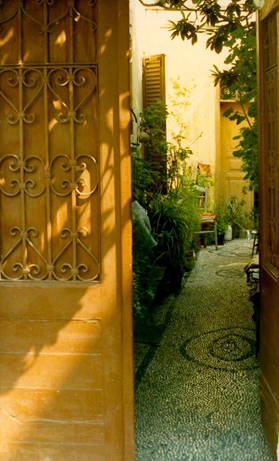
Courtyard of home in Rhodes, photo by Zumwalt
Of the approaches to cooking and foods from her Sephardic community in Macedonia, Jamila Kolonomos recalls, “But in that time the women in order to prepare the meals used measures, thus the measures were either small cups or small or large spoons. Nobody cooked the meals measuring in grams” (2014, 47). With the absence of refrigeration, “our recipes were for four people.” Kolonomos continues, “Also they didn’t cook the meals in the oven or furnaces by fixed degrees. If not over a strong or lukewarm fire, frequently in the mangal, with the ashes regulating the coal. They would cover them or they would keep them open according to the need” (2014, 41; translated from Judeo-Spanish by Isaac Jack Lévy).
Isaac remembers the aroma of the foods wafting through the narrow streets of Rhodes, “You could walk in the streets and smell the fragrance of La Juderia. The streets were so narrow that they contained the aroma. Wherever you went on a Friday or a holiday you could smell the food, and you could actually tell what they were cooking.” Food and family form composite snap-shots in Isaac’s memories from his early years in Rhodes:
- Isaac as a little boy holding the hand of his big brother Julian as they walked through the cobblestone streets to Mr. Davichon’s lokanda (restaurant), where long before they arrived they could smell the aroma of the shish kebab wafting to them, as if enticing them along.
- Isaac as a Figlio della Lupa, which was an Italian Fascist boy’s organization. He recalled,
We went to summer camp for two weeks . . . . They used to make us exercise, sun bathe every day – lie down in the sand and sun bathe. And the priest always said that the Jews and the Muslims had to pray their own way, not the Christian way. We were about to come home, it was Friday afternoon . . . and they gave us sandwiches, panini, with ham and cheese. Now we knew that we couldn’t eat ham so we made a deal with the Catholics, “I’ll give you my ham, if you give me your cheese.” We knew it wasn’t kosher. [Isaac laughs.] On Friday night we used to eat with Uncle Isidor. And my grandfather who was a Zionist but not very religious lifted up the cup of wine to say the blessing, and my two cousins and I crossed ourselves, because we saw that from the Catholic boys [at camp]. My grandfather stopped the blessing, looked at us, and said, with uncharacteristic sternness, “Out! Out!” And we went to our rooms and we didn’t have supper that night.
- Grandma Sarota, in the early morning of summer at 5 a.m., taking Julian in her right hand and Isaac in her left, and walking down through La Puerta de la Mar, out along the beautiful beaches to the Castaldo Bakery & Delicatessen. The people in the bakery knew to expect the Lévy brothers. The assistant had already prepared the sandwiches: hot panini right out of the oven, sliced open, with a slathering of real butter, and fresh anchovies. Isaac concluded “And that would be our breakfast, for five times a week, until school opened.”
Significantly, Isaac’s family and other Jewish families, learned about the end of their lives in Rhodes when gathered around the table, a memory rendered in the verse of the following song, which conveys the receipt of the news published in Il Messagero della Sera, about the pact between Hitler and Mussolini in 1938.4
|
Prima notche de septembre Asentados a komer Los djurnales en la mano Mos salio este haber. |
The first night of September Seated to eat While holding the newspapers We received this news. |
Isaac remembers his relatives reading about the racial laws and the worry of his mother, grandmother, grandfather, and other members of his family as they contemplated the imperative to leave their beautiful island.
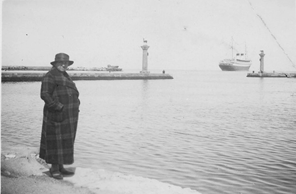
Unknown woman, harbor of Rhodes, circa 1930, Levy Photo Collection

View of Rhodes from harbor, 1990, photo by Zumwalt
In Transit, from Rhodes to Tangiers
With the generosity of Uncle David Musafir, who had been born in Milas, Turkey, and was a successful businessman from Montgomery, Alabama, Isaac, his mother, and his grandmother traveled first class on board the passenger ship from Rhodes to Genova, and then on to the international city of Tangiers, Morocco.5 While a way of life had ended for Isaac’s mother and his grandmother, for Isaac as a small boy, it was all an adventure.
Isaac recalls eating all their meals in the first-class dining room, always at the same table, which was covered with a linen cloth. Isaac recounts:
We were traveling in first class thanks to Uncle David because we couldn’t take any money out of Rhodes, and the waiters used to bring antipasto. And my grandmother, mother, and I used to eat it and we loved it! And they brought it to us every day. My grandmother used to say, “Es bueno esto! Es bueno! This is good! It’s good!” But we never realized that we were eating ham: it was prosciutto, and we had kept a kosher home.
The boat stopped in Barcelona in the morning on the last leg of the trip to Tangiers. This was right after the Spanish Civil War, which had ended on March 28, 1939. Isaac remembers the walls of the warehouses shattered from the ravages of warfare. Little boys, younger even than he was at ten years, lined up along the pier: they “were poor, no shoes, short pants.” Due to food shortages, the little boys of Barcelona had no bread, but they had luscious, big oranges. “First they would throw the nice Spanish oranges to us, and we used to take the bread, we would gather it up, take it to the side of the boat, and throw it to the boys. Some of the rolls would fall in the water and the little boys would dive in to gather even the wet bread.”
Tangiers, to Montgomery, to Atlanta.
The food shortages of the little boys and their families in Barcelona were present also in Tangiers. Isaac remembers coming home from school for lunch, but his mother had nothing to feed him. From time to time, he would visit the home of the principal of L’Alliance Israëlite, Mr. Israel, and his wife, who was the principal of the girls L’Alliance Israëlite, “And I used to visit them quite a lot, and I played with their children, and I had lunch with them. And one of our favorite meals was a sandwich with Spam. And we never knew [it was ham].” I asked Isaac if they knew, and he said, “I’m sure. They were more liberal than we were.”
Isaac, at age fourteen, his mother, and his grandmother left Tangiers in December 1944, for the southern route to New Orleans. As Lidia Marte discusses, immigrants “are ‘seasoned’ into new social relations” (2008, ix). For Isaac, the “new social relations” were comprised of his new family with a new set of etiquette. He recalls:
On our trip, we landed in New Orleans. Uncle David picked us up. And took us to Montgomery, and all the family was there . . . . Aunt Clara [Musafir] had a banquet for all of us. Well, one of the main dishes was fried chicken. So I took my fork and knife trying to cut it; it was the drumstick. And Aunt Clara said, “No, no, kon la mano! Kon la mano! With your hands, with your hands.” My mother looked at me, and shook her head, like, “Don’t, don’t” – a gesture. And Aunt Clara said, “Here we use the fingers!” So Mama didn’t want to contradict her. So I took it and started to eat it with my fingers, and I said, “Esto es mejor! Esto es mejor! That’s better! That’s better!”
In the following food narrative, Isaac recounts a story about etiquette and eating with the hands, but this is in reverse of the story about his learning to eat fried chicken with his hands.
My mother after many years remarried and she moved to Brooklyn. That was in 1947 after the war. And you couldn’t find any rooms because of all the returning soldiers. And a woman who used to be my grandmother’s servant in Milas and who used to take care of my mother, offered my mother and father a room. A year later or so, I decided to go to school in New York and they made room for me in the living room. I used to sleep on the couch. The wife told her husband, Rahamim, who was a good man but illiterate, “Now, Isaac is going to come. So eat properly, use the fork and everything.” So the first night when I got there, they had meatballs. And Mr. Rahamim picked up his knife and fork, cut the meatballs in half, put the utensils down, and picked up half of it and put it in his mouth.
Lidia Marte discusses food and foodways “as contested sites of power negotiations, as strategic reclamation of ‘small measures of autonomy’” (2008, ix). It was as if Mr. Rahamim was asserting his small measure of autonomy, as if he were thinking, “I’ll meet you halfway on this etiquette-thing. I’ll cut my food with a knife and fork, but I’m eating with my fingers!” (Isaac, by the way, doesn’t agree with my use of Marte here and the “contested sites of power negotiations.” He thinks that Mr. Rahahmim simply thought the knife and fork were for cutting, but not for conveying the food to the mouth!)
The world of food opened up for Isaac in New York. He had encountered prosciutto on board the boat and Spam in Tangiers, but in Brooklyn, he discovered sausages!
While I was going to college, I worked for a small trucking company in lower Manhattan. For lunch we used to go to a real Italian delicatessen. While I was there I saw the sausage hanging and I knew the guy. He said, “Buy two pounds, go home and hang them. Then as you eat them, get more. You want them to dry, and then use them.” So I hung them in the basement in Brooklyn. I used to take one, either make a sandwich or fry them with eggs in the morning. One day Grandma went down in the basement. She looked at them and said, “What’s that?” And I said, “Sausages.” And she said, “They’re not kosher.” She made me eat them in the basement but I couldn’t take them up to the kitchen.
With the changes of place and of food, Isaac’s mother and grandmother met the challenges by offering comfort in the form of food. Ever ready to feed anyone and everyone who crossed the threshold, the Sephardic nikuchira (housewife) had a ready supply of burekas, biskochos, olives, feta cheese, roskas, and huevos haminados. When Isaac and I would visit Mama in her apartment in Atlanta, she would serve us a breakfast of precisely these foods – a treat you could find no place other than at her table. Our Aunt Judit would say, “Do you always feed them the same thing?” The answer, thankfully, was, “Yes.”
Isaac encountered the same foods and the same emphasis on food among the Sephardic community of Seattle where he was doing fieldwork. He recounts:
I was on sabbatical in Seattle, and I was staying in a motel and a gentleman, well dressed, came to pick me up at 7:30 a.m., “I’m your chauffeur.” Then I found out he was a retired banker. He left me at the first house and said he’d come back in a while and pick me up again. I’d already had my breakfast, but they insisted that I eat breakfast with Sephardic foods. I ate; the gentleman came to pick me up and took me to another house. It was about 10:00. They had the same food for me again. 12:00 – he took me to a 3rd house. First thing I had to do was lunch. I told them I’d already eaten, three times. “It’s okay, it’s noon. Lunch will not hurt you.” They fed me Sephardic food again.
Passing on the gift
A perfectionist in all her Sephardic cooking, my mother-in-law tried hard to teach her granddaughter, Cathy Lévy Ott, and me how to make burekas and biskochos. She would reach across the table to take our misshapen lumps of dough, our first attempts at making the crescents for the burekas or the circles of the biskochos, and she would redo them. Her hands moved with deftness and artistry, born of the more than seventy years of shaping and cooking these foods. I would give up in frustration at having each of my attempts at creation undone. Cathy would ask me, “Rosemary, why aren’t your making burekas?” And my mother-in-law, covering for me, would say, “Rosemary already knows how!”
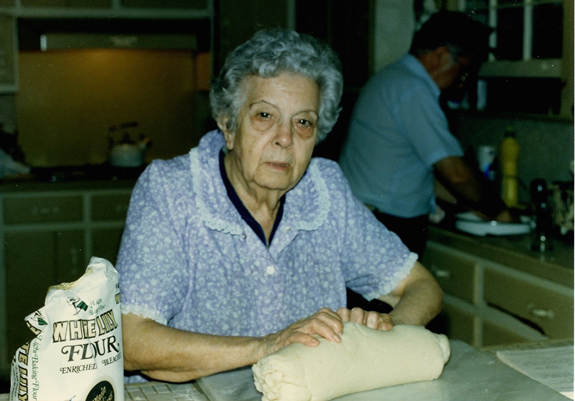
Mama making burekas, 1987, photo by Zumwalt
To my shame, I admit now that it took me twelve years after my mother-in-law’s passing to teach myself to make burekas. I wonder as I roll out the little circles of dough, drop the teaspoon of potato or spinach filling in the center, and fold them carefully in half at the speed and skill of my mother-in-law as she crafted her Sephardic delicacies. I used, by the way, White Lily flour.
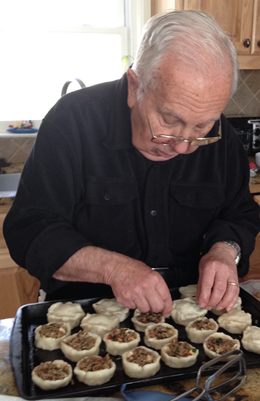
Isaac making pasteles, 2015, photo by Zumwalt
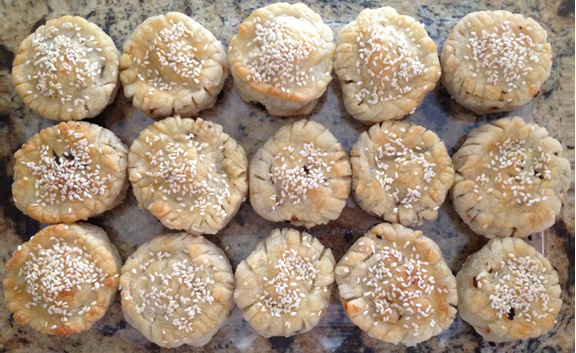
Pasteles by Isaac, 2015, photo by Zumwalt
In “Making Atlanta Home: Recollections of Place through Narrative” (2002), Isaac and I wrote about personal narratives as a means of carrying the sense of self to new locales, “A bit like a snail’s shell, the narratives provide a way of moving the home with oneself, of connecting in memory with a new place while refusing to abandon the other places from which one came” (80). In the present paper, I draw in the memories of special foods from the childhood home and of the taste of new foods. The personal narratives of food – of the remembered tastes and aesthetics of family foods – provide the antidote for ‘the anguish of solitude , . . of being detached from things and beings’,” as Marcel Proust maintained in À la recherche du temps perdu (Poulet 1956, 297). Moïse Rahmani writes precisely from the perspective of the anguish of being ripped apart from the familiar embrace of Rhodes. At the end of his book, Rhodes, un pan de notre mémoire, he draws the reader back to memory through the fragrance of foods:
Shut your eyes and without great effort, you make a journey back in time and space. The sun of the Mediterranean . . . revives you in soul and heart. The warmth envelops you . . . . Look at los muestros, our people . . . . Smell the fragrance of the burekas, the beans with raisins that cook under the yprakis . . . , the coffee with rose water, accompanied by roskas, or served with raki as part of the mezze: a bite of abudahu, some boyos, some pistachios, some salted almonds, and cucumbers, sliced length-wise (Rahmani 2000, 225; Zumwalt and Lévy’s translation from French)
Rahmani ends this recollection with the blessing, “Berakha y salud” [Blessings and health].
The telling of personal narratives comprises, as folklorist William Wilson emphasizes, the stories of our lives. Of his mother’s stories, Wilson writes, “ . . . ,she has been presenting herself to the world and capturing through these artistic forms the values and the people she holds dear” (2006, 270). In Stories of Our Lives, folklorist Frank de Caro adds a temporal element, “[T]he stories we tell and listen to play an integral role in constructing our temporal selves” (2013, ix). Isaac’s personal narratives about food capture, as Wilson says, the values of his family – values of nurturing all who cross the threshold into the home; and provide, as de Caro posits, for the changing, or temporalized view of self and others. To rephrase the saying, “We are what we eat,” one might say, “We are what we tell,” and what we tell includes the narrations of food and place, ultimately of our changing identities.
Notes
1. Rosemary Lévy Zumwalt (M.A. folklore, Ph.D. anthropology, University of California, Berkeley) is retired from Agnes Scott College in Decatur, Georgia, where she was vice president for academic affairs and dean of the college and professor of anthropology. Among other works, she is co-author with Isaac Jack Lévy of Ritual Medical Lore of Sephardic Women: Sweetening the Spirits and Healing the Sick (University of Illinois Press, 2002). Isaac Jack Levy is the author of And the World Stood Silent: Sephardic Poetry of the Holocaust (Urbana: University of Illinois Press, 1989, 1999). He is the founder of the American Society of Sephardic Studies, and distinguished professor emeritus of Spanish at the University of South Carolina.
2. I presented a version of this paper, titled, “White Lily Flour and Winn Dixie Rice: Bringing New Ingredients to the Taste of Foods from a Home Far-Away,” at the Western States Folklore Society Meetings, at the University of California, Los Angeles, in April 2015. I conducted all interviews with my husband Isaac Jack Lévy during the first week of March 2015. In this paper, I use Judeo-Spanish orthography, which differs from that of modern Spanish. For exquisite photos of Sephardic foods from Rhodes and detailed recipes, see Elsie Menasce, The Sephardi Culinary Tradition (1984). For another Rhodesli culinary perspective, see Stella Cohen’s Stella’s Sephardic Table (2012). For the Sephardic community cookbook, see The Sephardic Cooks (1981). And for a Turkish and Sephardic perspective on memoir and foods, see Beyhan Çağrı Trock, The Ottoman Turk and the Pretty Jewish Girl, Real Turkish Cooking (2012).
3. I thank Stella Levy, who lived in Rhodes, is a survivor of the Holocaust, and is a veritable font of information about life in Rhodes, for this information (personal communication to Isaac J. Lévy, March 12, 2015).
4. See “Benito Mussolini: Italian Fascist, His Racial Laws, and Ultimate Downfall Part 4: Attack on the Jews,” http://judithrizzo.hubpages.com/hub/Benito-Mussolini-Italian-Fascist-His-Racial-Laws-and-Ultimate-Downfall-Part-4, accessed 19 Mar. 2015.
5. Isaac’s brother Julian had made the long journey by himself when he was ten-years old, from Rhodes to New York by ship under the care of the captain, and then from New York to Atlanta by train, to live with his mother’s aunt, Judit Piha, and her family. I write this story of Julian & Isaac, The Lévy Brothers on the Isle of Rhodes in a privately printed booklet (blurb, 2012) to honor the life of Julian Lévy (1927-2012).
References Cited
Cohen, Stella. 2012. Stella’s Sephardic Table. Cape Town, South Africa: Hoberman Collection.
De Caro, Frank. 2013. Stories of Our Lives. Logan: Utah State University Press.
Kolonomos, Jamila. 2014. “Memoria, Uzos, Mantinision Kumeris” (Memories, Uses, Food Resources), Aki Yerushalayim 35(96):47.
Lévy, Isaac Jack and Rosemary Lévy Zumwalt. 2002. “Making Atlanta Home: Recollections of Place through Narratives,” Folklore Forum 33(1/2):67-81.
Marte, Lidia. 2008. “Migrant Seasoning: Food Practices, Cultural Memory, and Narratives of ‘HOME’ among Dominican Communities in New York City,” Ph.D. dissertation, University of Texas.
Menasce, Elsie. 1984. The Sephardi Culinary Tradition. Cape Town, South Africa: The Sephardic Cookbook Corporation.
Poulet, Georges. 1956. Studies in Human Time. Trans. Elliott Coleman. Baltimore, Maryland: Johns Hopkins University Press.
Rahmani, Moïse. 2000. Rhodes, un pan de notre mémoire [Rhodes, A Slice of Our Memory]. Paris: Romillat.
Steinberg, Ellen F. and Jack H. Prost. 2011. From the Jewish Heartland, Two Centuries of Midwest Foodways. Urbana: University of Illinois Press.
The Sephardic Cooks. 1981. Atlanta, Georgia: Congregation Or veShalom Sisterhood.
Trock, Beyhan Çağrı. 2012. The Ottoman Turk and the Pretty Jewish Girl: Real Turkish Cooking. [United States]: Cupper James Publishing.
Wilson, William A. 2006. The Marrow of Human Experience, Essays on Folklore, ed. Jill Terry Rudy. Logan: Utah State University Press.
Zumwalt, Rosemary Lévy. 2012. Julian & Isaac, The Lévy Brothers on the Isle of Rhodes. Privately printed: blurb.
